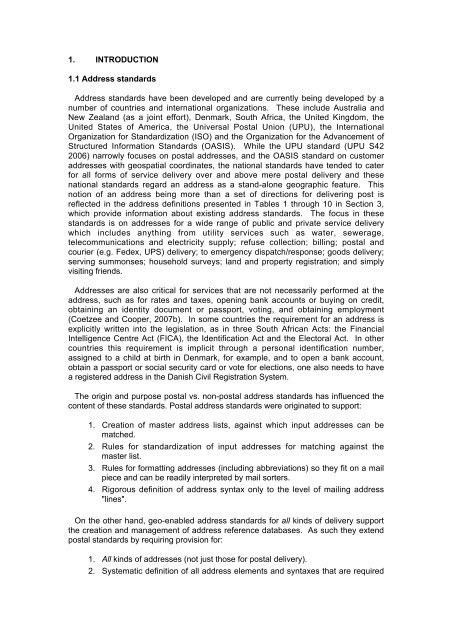Towards an international address standard (English) - ISO/TC 211
Towards an international address standard (English) - ISO/TC 211
Towards an international address standard (English) - ISO/TC 211
Create successful ePaper yourself
Turn your PDF publications into a flip-book with our unique Google optimized e-Paper software.
1. INTRODUCTION<br />
1.1 Address st<strong>an</strong>dards<br />
Address st<strong>an</strong>dards have been developed <strong>an</strong>d are currently being developed by a<br />
number of countries <strong>an</strong>d <strong>international</strong> org<strong>an</strong>izations. These include Australia <strong>an</strong>d<br />
New Zeal<strong>an</strong>d (as a joint effort), Denmark, South Africa, the United Kingdom, the<br />
United States of America, the Universal Postal Union (UPU), the International<br />
Org<strong>an</strong>ization for St<strong>an</strong>dardization (<strong>ISO</strong>) <strong>an</strong>d the Org<strong>an</strong>ization for the Adv<strong>an</strong>cement of<br />
Structured Information St<strong>an</strong>dards (OASIS). While the UPU st<strong>an</strong>dard (UPU S42<br />
2006) narrowly focuses on postal <strong>address</strong>es, <strong>an</strong>d the OASIS st<strong>an</strong>dard on customer<br />
<strong>address</strong>es with geospatial coordinates, the national st<strong>an</strong>dards have tended to cater<br />
for all forms of service delivery over <strong>an</strong>d above mere postal delivery <strong>an</strong>d these<br />
national st<strong>an</strong>dards regard <strong>an</strong> <strong>address</strong> as a st<strong>an</strong>d-alone geographic feature. This<br />
notion of <strong>an</strong> <strong>address</strong> being more th<strong>an</strong> a set of directions for delivering post is<br />
reflected in the <strong>address</strong> definitions presented in Tables 1 through 10 in Section 3,<br />
which provide information about existing <strong>address</strong> st<strong>an</strong>dards. The focus in these<br />
st<strong>an</strong>dards is on <strong>address</strong>es for a wide r<strong>an</strong>ge of public <strong>an</strong>d private service delivery<br />
which includes <strong>an</strong>ything from utility services such as water, sewerage,<br />
telecommunications <strong>an</strong>d electricity supply; refuse collection; billing; postal <strong>an</strong>d<br />
courier (e.g. Fedex, UPS) delivery; to emergency dispatch/response; goods delivery;<br />
serving summonses; household surveys; l<strong>an</strong>d <strong>an</strong>d property registration; <strong>an</strong>d simply<br />
visiting friends.<br />
Addresses are also critical for services that are not necessarily performed at the<br />
<strong>address</strong>, such as for rates <strong>an</strong>d taxes, opening b<strong>an</strong>k accounts or buying on credit,<br />
obtaining <strong>an</strong> identity document or passport, voting, <strong>an</strong>d obtaining employment<br />
(Coetzee <strong>an</strong>d Cooper, 2007b). In some countries the requirement for <strong>an</strong> <strong>address</strong> is<br />
explicitly written into the legislation, as in three South Afric<strong>an</strong> Acts: the Fin<strong>an</strong>cial<br />
Intelligence Centre Act (FICA), the Identification Act <strong>an</strong>d the Electoral Act. In other<br />
countries this requirement is implicit through a personal identification number,<br />
assigned to a child at birth in Denmark, for example, <strong>an</strong>d to open a b<strong>an</strong>k account,<br />
obtain a passport or social security card or vote for elections, one also needs to have<br />
a registered <strong>address</strong> in the D<strong>an</strong>ish Civil Registration System.<br />
The origin <strong>an</strong>d purpose postal vs. non-postal <strong>address</strong> st<strong>an</strong>dards has influenced the<br />
content of these st<strong>an</strong>dards. Postal <strong>address</strong> st<strong>an</strong>dards were originated to support:<br />
1. Creation of master <strong>address</strong> lists, against which input <strong>address</strong>es c<strong>an</strong> be<br />
matched.<br />
2. Rules for st<strong>an</strong>dardization of input <strong>address</strong>es for matching against the<br />
master list.<br />
3. Rules for formatting <strong>address</strong>es (including abbreviations) so they fit on a mail<br />
piece <strong>an</strong>d c<strong>an</strong> be readily interpreted by mail sorters.<br />
4. Rigorous definition of <strong>address</strong> syntax only to the level of mailing <strong>address</strong><br />
"lines".<br />
On the other h<strong>an</strong>d, geo-enabled <strong>address</strong> st<strong>an</strong>dards for all kinds of delivery support<br />
the creation <strong>an</strong>d m<strong>an</strong>agement of <strong>address</strong> reference databases. As such they extend<br />
postal st<strong>an</strong>dards by requiring provision for:<br />
1. All kinds of <strong>address</strong>es (not just those for postal delivery).<br />
2. Systematic definition of all <strong>address</strong> elements <strong>an</strong>d syntaxes that are required
















